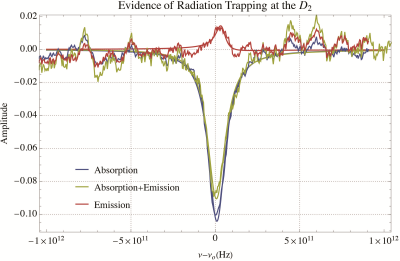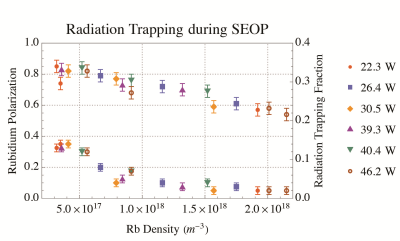1802
In situ evidence of radiation trapping limiting Rb polarization in common SEOP setups1Department of Physics and Astronomy, University of North Carolina - Chapel Hill, Chapel Hill, NC, United States
Synopsis
To increase the 129Xe polarization for emerging biomedical applications, the Rb polarization on which the 129Xe directly depends must be first optimized. Radiation trapping is a form of Rb depolarization thought to be quenched by the N2 added to SEOP gas mixtures. Here we use absorption spectroscopy to measure the Rb density, optical spectroscopy to monitor the fraction of Rb atoms involved in radiation trapping, and field cycling to measure the Rb polarization. We find that radiation trapping is still present during spin-exchange optical pumping and appears to limit the achievable Rb polarization.
Introduction
To produce large volumes of hyperpolarized (HP) 129Xe for human studies it is necessary to optimize the Rb polarization, on which the 129Xe polarization directly depends. Radiation trapping is a source of Rb depolarization, which occurs as the 5p3/2 state becomes thermally accessible to atoms optically pumped in the 5p1/2 state. When the excited electrons decay from the 5p3/2 into the 5s1/2 ground state, they emit unpolarized photons, which can then be reabsorbed and depolarize the Rb vapor2,3. Most common models for HP 129Xe assume that this process is quenched by the N2 added as buffer to the gas mixture, typically 10% of several atm4,5. Here we use optical spectroscopy to monitor in situ D2 emission during optical pumping and find that radiation trapping is still present despite 10% of N2 buffer gas, in particular for high pump laser power and low Rb density. To our knowledge, direct measurements of radiation trapping and Rb polarization has never been reported.Methods
A (5 cm x 10 cm) optical cell containing several atm of 1/10/89 Xe/N2/He was heated using a heater wire with a PID controller to create a Rb vapor. The pump laser (BrightLock 170W 795nm, QCP Lasers) was turned on and the cell temperature was allowed to restabilize. The Rb polarization was measured using the field cycling method, which compares the absorption of laser light with and without a magnetic field, with a power meter placed at the back of the optical cell1,6. The Rb polarization measurement was repeated three times for each temperature and laser power combination, and the average value was calculated. During these measurements, an optical spectrometer was used to monitor the emission at the D2 line. After the third measurement, the halogen lamp used for absorption spectroscopy was turned on and the pump laser was turned off and spectra were immediately taken to measure the Rb density.Results and Discussion
Figure 1 shows an example of the observed D2 emission during optical pumping and the absorption spectrum used to measure the Rb density. Figure 2 shows the Rb polarization and fraction of Rb atoms participating in radiation trapping as a function of Rb density for multiple pump laser powers.The radiation trapping rate was observed to be proportional to the optical pumping rate, that is the rate at which electrons are excited to the 5p1/2 state, consistently with previous findings7. As, for a given pump laser power, the optical pumping rate increases as the Rb density decreases, the relative prevalence of radiation trapping was found to closely track Rb polarization (Fig. 2). As the radiation trapping scales with optical pumping rate, and therefore pump power, at low Rb densities the polarization reaches a maximum and additional pump power does not lead to higher Rb polarization (see polarization values for the 22.3 W and 39.3 W laser powers for Rb densities of 3-5 x1017 m-3 in Fig. 2). Measurements with pump power above 50 W were not made as, for these temperatures (90-120 °C), the Rb density and the cell temperature were found extremely unstable.
Conclusions
We use optical spectroscopy measurements to monitor radiation trapping for a variety of Rb densities and pump laser powers. We find that radiation trapping is still present under experimental conditions commonly used to produce HP 129Xe and appears to limit the achievable Rb polarization, even at low Rb densities and high laser power. With the move towards higher power lasers for SEOP production of clinical size gas volumes, it is important to understand the impact of higher optical pumping rates and, consequently, higher radiation trapping rates. These results also suggest that further work into optimizing buffer gas mixtures should be done to increase the Rb and 129Xe polarization.Acknowledgements
This work was supported by the NIH under Grant Nos. R01DK108231 and R01DK123206, Dr. Branca’s startup fund, and the NSF Graduate Research Fellowship (No. DGS1650116).References
1. Kelley, M. & Branca, R. T. Theoretical models of spin-exchange optical pumping: Revisited and reconciled. J. Appl. Phys. 129, 154901 (2021).
2. Saha, I., Nikolaou, P., Whiting, N. & Goodson, B. M. Characterization of violet emission from Rb optical pumping cells used in laser-polarized xenon NMR experiments. Chem. Phys. Lett. 428, 268–276 (2006).
3. Mortuza, M. G., Anala, S., Pavlovskaya, G. E., Dieken, T. J. & Meersmann, T. Spin-exchange optical pumping of high-density xenon-129. J. Chem. Phys. 118, 1581–1584 (2003).
4. Skinner, J. G. et al. High Xe density, high photon flux, stopped-flow spin-exchange optical pumping: Simulations versus experiments. J. Magn. Reson. 312, (2020).
5. Kelley, M., Burant, A. & Branca, R. T. Resolving the discrepancy between theoretical and experimental polarization of hyperpolarized 129Xe using numerical simulations and in situ optical spectroscopy. J. Appl. Phys. 128, 144901 (2020).
6. Nikolaou, P. et al. Near-unity nuclear polarization with an open-source 129Xe hyperpolarizer for NMR and MRI. Proc. Natl. Acad. Sci. U. S. A. 110, 14150–14155 (2013).
7. Rosenberry, M. A., Reyes, J. P., Tupa, D. & Gay, T. J. Radiation trapping in rubidium optical pumping at low buffer-gas pressures. Phys. Rev. A - At. Mol. Opt. Phys. 75, 1–6 (2007).
Figures

Figure 1 Example of in situ monitoring of the D2 emission under optical pumping (red). The absorption line (blue) used to measure the Rb density is taken with the halogen lamp on, but with the pump laser off. To optimize the fitting, the absorption and emission data were added together (green) before fitting and integrating. The radiation trapping fraction was taken to be the area of the blue minus the green curve divided by the blue curve.
